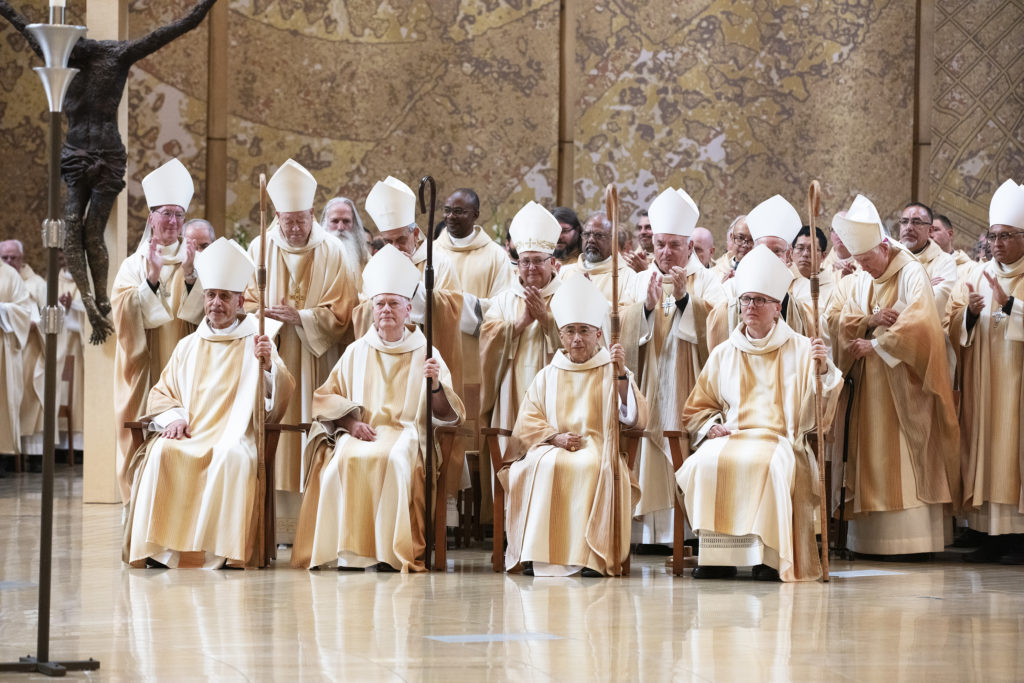In his homily at their Sept. 26 episcopal ordination Mass, Archbishop José H. Gomez told the Archdiocese of Los Angeles’ four newest auxiliary bishops that their mission as successors to Jesus’ first apostles of leading men and women to eternal salvation was an “urgent” one.
Whether by coincidence or not, the “episcopal mottos” chosen by Albert Bahhuth, Matthew Elshoff, Brian Nunes, and Slawomir Szkredka all carry a similar sense of urgency. Here’s a look at the four mottos chosen and what they mean to each new bishop.
BISHOP ALBERT MATTA BAHHUTH: “Go make disciples”
With experience in chemical engineering, running a fast-food franchise, and helping run the country’s largest archdiocese, Bishop Albert Bahhuth knows a few things about complicated assignments. But he says his newest one comes down to something simple.
“If I help one person to come to know Jesus, that person will have eternal life,” wrote Bishop Bahhuth soon after his appointment by Pope Francis in July.
He was explaining his choice of motto, taken from the risen Christ’s instructions in the Gospel of Matthew: “Therefore go and make disciples of all nations, baptizing them in the name of the Father and of the Son and of the Holy Spirit” (Matthew: 29:19).
What does Bahhuth make of those words?
“A lot of times we jump into the ‘doing’ but without Jesus,” Bahhuth told Angelus. “And Jesus has to come first, because he’s the reason we do whatever we do. We don’t do good things because we want to be good people.”
Bahhuth, who turned 67 on Oct. 6, sees his mission as being united to Jesus through prayer and proclaiming the truth of salvation in Christ.
“That’s the way we fight evil today. I think it’s simple. A lot of times we make it complicated, but what it comes down to is this: Are we making disciples, are we proclaiming the kingdom as Jesus did?”
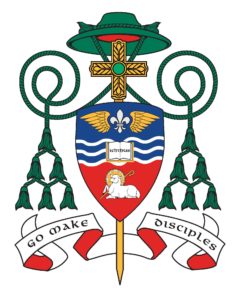
Coat of arms
To reflect devotion to Mary, Bishop Bahhuth’s coat of arms (and those of his fellow new auxiliary bishops) include two symbols traditionally associated with Blessed Virgin Mary: the blue field at the top of the shield, and the “Fleur de Lys,” the lily shaped symbol in the upper center of the shield. The two wings represent the Archdiocese of Los Angeles, named after Our Lady Queen of the Angels.
Below, the wavy lines — which represent water, movement and resettlement in heraldry — honor Bahhuth’s movement from his native Lebanon to Los Angeles. The water theme also honors the bodies of water associated with both places — the Mediterranean Sea and the Pacific Ocean — and the waters of baptism.
The image of an open book at the center of the shield with the word “ICHTHUS” (the early Church’s emblem identifying one as a secret devotee of Jesus Christ, Redeemer of Mankind) signifies Bahhuth’s desire to bring the knowledge of Christ to everyone.
The red in the bottom portion of the shield represents the blood of Christ, particularly in the form of the Precious Blood of the Eucharist. Upon the red field is the Catholic heraldic emblem for the Good Shepherd chosen by Bahhuth.
BISHOP MATTHEW GREGORY ELSHOFF: “Caritas Christi urget nos” (“The love of Christ compels us”)
The official English translation of his motto uses the verb “compel,” but Bishop Matthew Elshoff likes “push,” too.
The love of Christ, or “caritas Christi,” to use the familiar Latin phrase in Elshoff’s motto, is something that is experienced “in our hearts and our souls.”
The 68-year-old Capuchin said he’s experienced what that love can do in his own life, whether in special moments such as prayer retreats or in the middle of hard times. And as a priest, he’s seen it at work in others.
“It’s about grace coming into someone’s life because of a sacramental moment, and they’re just overwhelmed, and you see that love of Christ just pushing them forward and urging them.”
Looking ahead, Elshoff sees the motto guiding his most important day-to-day duty as a bishop.
“One cannot give what one does not have, so it’s going to start with my personal prayer.” Elshoff said that will include the celebration of the Eucharist, daily time before the Blessed Sacrament, and praying the Liturgy of the Hours.
He expects much of his work as episcopal vicar to involve supporting the priests and deacons in the Our Lady of the Angels Pastoral Region in the difficulties they often face. To experience the love of Christ, he believes, is to know that you’re not alone.
“That love must be shared because in some ways, we don't even have any control over it. Yes, we have free will, but we are so overwhelmed with it that it urges us, then, to share the love of Christ with others.”
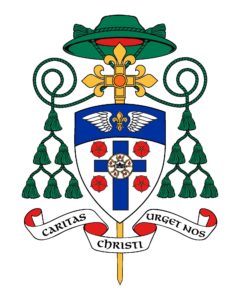
Coat of arms
Below the traditional symbolism honoring Mary and the angels, Bishop Matthew Elshoff’s devotion to St. Francis, the Holy Stigmata, and the Eucharist is represented in a design with a Eucharistic host at the center. Within the host are five droplets of blood, signifying the five wounds of Christ. At the center of the host is the traditional Christological monogram IHS, or “In hoc signo (vinces)” which translates from Latin to “In this sign you will conquer.”
The blue cross represents the Missionary Cross of Christianity in traditional Catholic heraldry, symbolizing Elshoff’s missionary experience. His devotion to Our Lady of Guadalupe is represented by the four roses at each open corner outside the cross.
BISHOP BRIAN ALAN NUNES: “In mundum universum praedicate evangelium” (“Preach the Gospel to the whole world”)
The phrase chosen by Bishop Brian Nunes for his episcopal motto is a clear mandate from Jesus to Christians. But its words also have a personal meaning for the son of immigrants from Hong Kong and Macau.
“I wanted some way of connecting to the fact that my family comes from the other side of the world,” said Nunes. He noted that the faith came to that part of Asia thanks to missionaries who practiced the words of Jesus in Mark 16:15.
To that end, Nunes also chose to illustrate his episcopal coat of arms with a Chinese-style junk boat. The detail is both a nod to his Asian heritage and a symbol of the Catholic Church, which since ancient times has been described as a ship that carries people to salvation across the waters of earthly life.
Nunes, who turns 59 this Oct. 26, says the new assignment that awaits him is “outside of my comfort zone, because it’s all new.” But looking to the present, the message seems clear enough.
“We're being called to go into the world and not just wait for people to come to us but to be active in proclaiming the gospel, the good news of Jesus.”
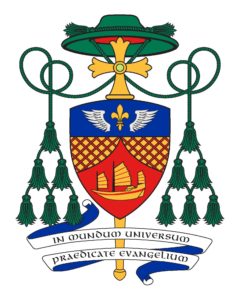
Coat of arms
Below the traditional symbolism honoring Mary and the angels, the rest of the shield of Bishop Nunes’s coat of arms is divided in two areas.
The red field represents the blood of Christ and the Eucharist, as well as the Pacific Rim region where his parents are originally from. A depiction of a Chinese junk boat recalls his roots in Macau and Hong Kong, and the Church as a ship of salvation. The boat’s gold color represents God’s eternal goodness.
The red and gold grid-like pattern in the upper sides of the shield suggest nets — specifically, the fishing nets used by the apostles as “fishers of men.”
BISHOP SŁAWOMIR SZKREDKA: “Quodcumque dixerit facite” (“Do whatever he tells you”)
Bishop Slawomir Szkredka’s choice for his episcopal motto reflects a couple of themes closely tied to his faith: love for Scripture and the Virgin Mary.
The words of the Virgin Mary to the servants at the wedding feast of Cana are an invitation to them — and to us — to “assume her own attitude of trust and whatever God demands or asks for,” he explained.
It’s a scene that Szkredka noted is uniquely linked to the crucifixion of Christ.
“Mary appears only in those two scenes in the Gospel of John,” said Szkredka, an accomplished Scripture scholar and author of “Icon of Trust: Mary in the Gospels of Luke and John” (Sophia Institute Press, $18.50).
The other reason Szkredka cites is more serendipitous: When he got the call from the apostolic nuncio informing him of Pope Francis’ decision to appoint him a bishop, he was on a four-day walking pilgrimage to the Shrine of Our Lady of Czestochowa in his native Poland. The Gospel passage traditionally read by pilgrims upon arriving at the shrine? The wedding feast of Cana.
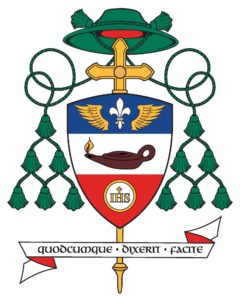
Coat of arms
Below the traditional symbolism honoring Mary and the angels, the rest of the shield of Bishop Szkredka’s coat of arms is divided into two fields.
The middle one has a white background, representing God’s purity, humility, and goodness. Upon it is a depiction of the “the lamp of wisdom” that represents Szkredka’s love for Scripture and the word of God, which illuminates the hearts and minds of men and women.
The red background of the bottom area represents the blood of Christ and the Eucharist, while at the center is a white Eucharistic host with the traditional Christological monogram IHS, or “In hoc signo (vinces)” which translates from Latin to “In this sign you will conquer.” The use of red and white (the colors found in Poland’s flag) in the shield are a subtle tribute to Szkredka’s Polish heritage.
Coat of arms artwork and explanations courtesy of James‐Charles Noonan Jr.
